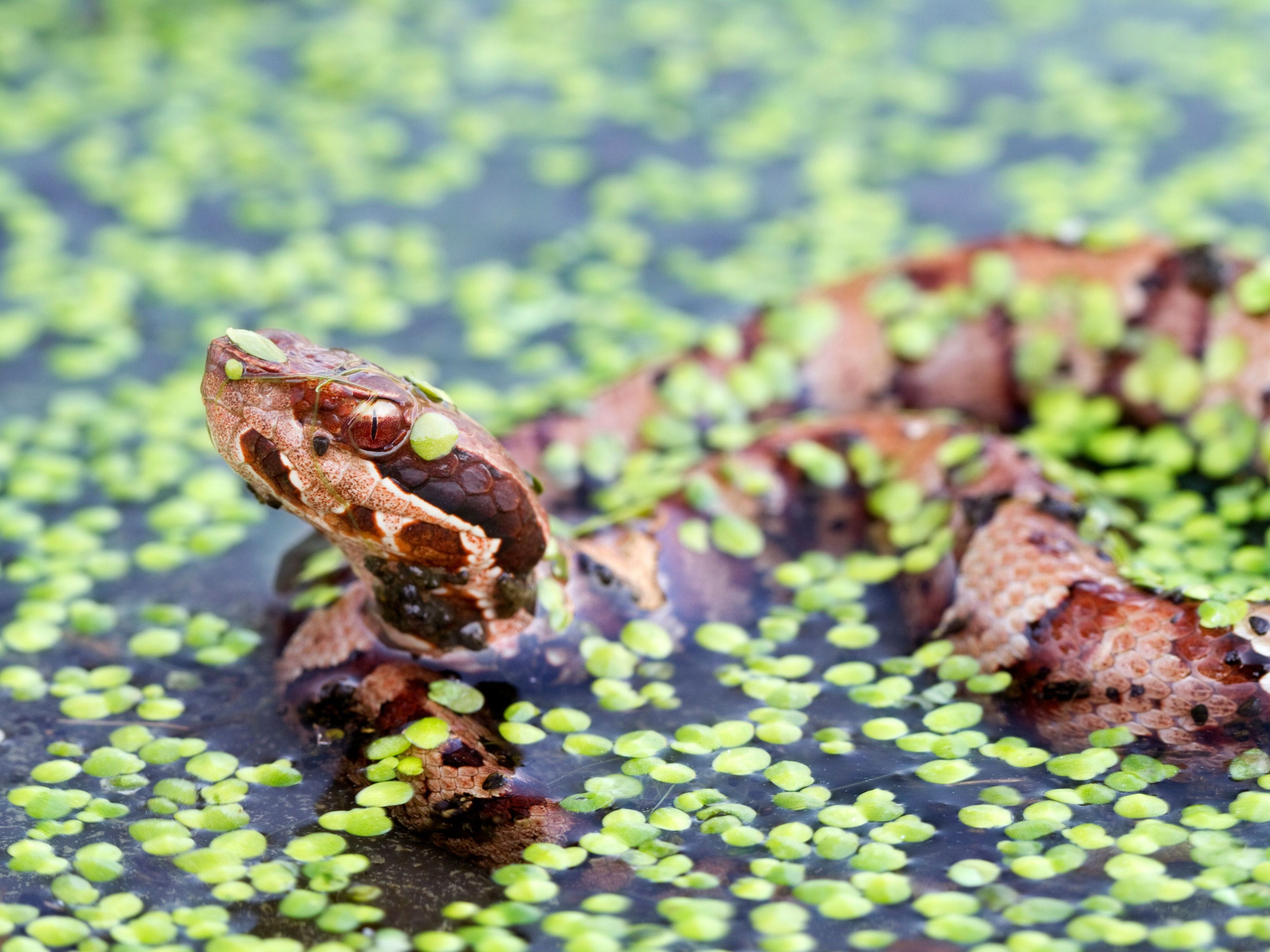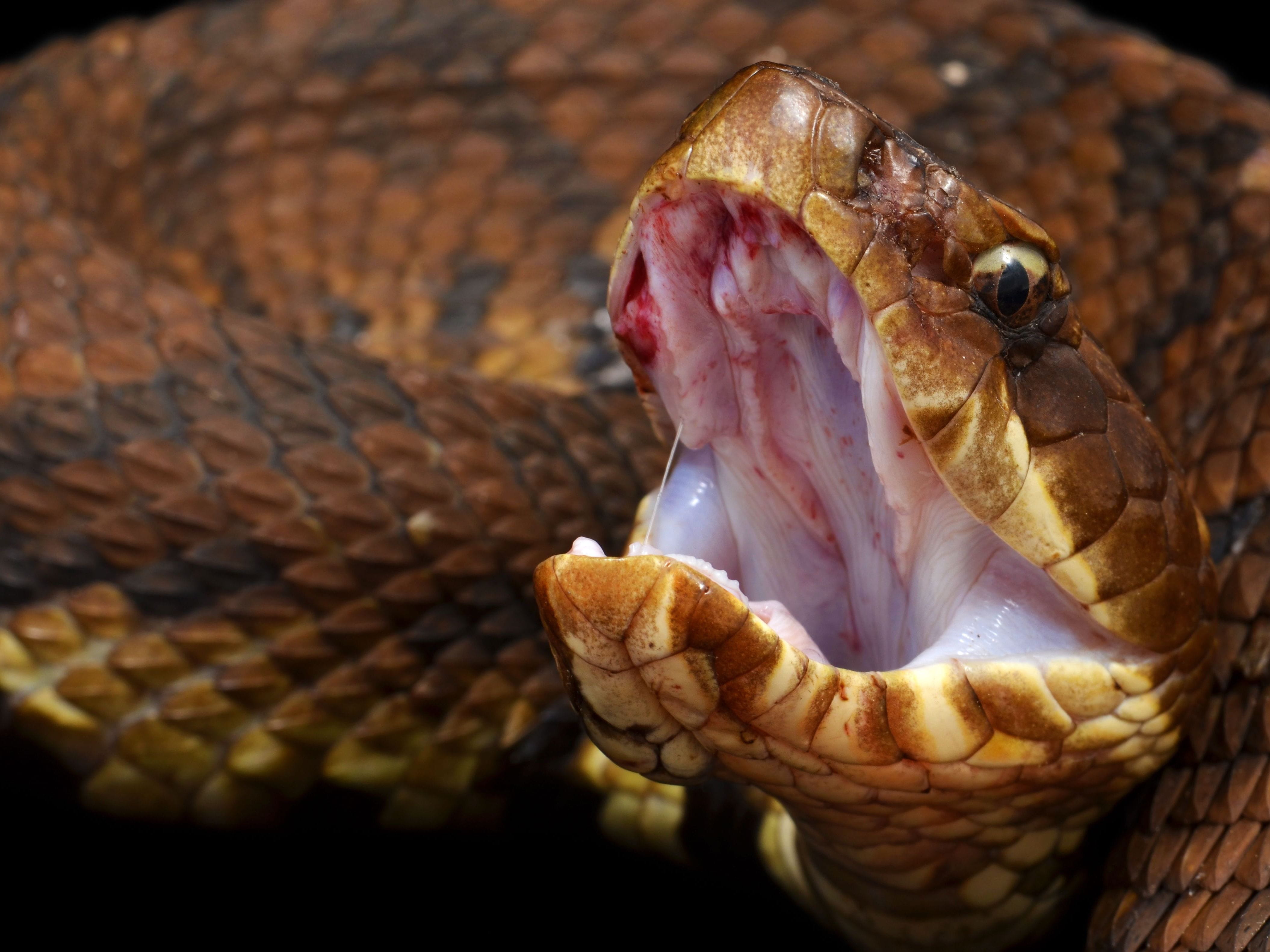How Venomous are Cottonmouth Snakes?

The Bottom Line
Cottonmouth snakes are a type of venomous pit viper found in the South East US. They are semiaquatic and are found near water, which is why they are also referred to as water moccasins. Cottonmouths prefer to leave you alone, but occasionally do bite. The most common symptoms of a cottonmouth bite are pain and swelling of the affected area, which may need treatment with antivenom.

What is a cottonmouth and where do they live?
Cottonmouths are venomous pit vipers that are found in the South East US. They are found as far north as Virginia and their range extends into Eastern Texas and down through Florida. Cottonmouths may also be found in zoos and as exotic pets outside of their usual geographic range. They are semiaquatic and are usually found near bodies of water, which is why they are sometimes called water moccasins. They can be found on land, but they are also strong swimmers. Of note, cottonmouths are not able to bite under water.How to identify a cottonmouth snake.
Cottonmouths are about 2 to 4 feet in size. They have a jagged light-brown-on-darker-brown scale pattern, that is sometimes described as “pixelated.” As cottonmouths get older, they become darker and almost black in color. Cottonmouths also have a characteristic cotton-white mouth with fangs. Their heads are triangular in shape and they have heat-sensing pits that look like nostrils. They have a dark band across their eyes, which looks like a Zorro mask. Their pupils are elliptical in shape. Young snakes may also have a yellow-green tail.
Cottonmouths may shake their tails, but they do not have rattles. It may be hard to identify a cottonmouth if it is covered in mud when it is nearby water. Cottonmouths are commonly confused with water snakes that live in the same area. Water snakes have a less jagged scale pattern and round heads. They have round pupils and do not have the Zorro mask stripe behind they eye. In addition, they have vertical bars underneath their mouth and do not have sharp fangs.
Do cottonmouths chase people?
One common myth is that cottonmouths are aggressive and that they chase people. This could not be further from the truth. Cottonmouths prefer to be left alone. If they feel threatened, they may show their white mouth and fangs as a warning and shake their tail. If that is the case, just walk away. They won’t chase you.
Are cottonmouth snakes venomous?
Cottonmouth snakes are venomous, but the symptoms are usually limited to pain and swelling of the affected area. These local symptoms can be quite painful and it may take a few weeks to make a full recovery. Systemic symptoms are rare with cottonmouth bites, but the most common signs and symptoms are nausea and vomiting, low platelets, and abnormal blood clotting. Some bites are “dry bites” meaning that the snake does not inject any venom and symptoms are milder.
Is there a treatment for a cottonmouth snakebite?
There is an antivenom available for severe cottonmouth bites that trigger significant pain and progressive swelling. The antivenom slows or halts the swelling, but does not reverse it, and swelling can take time to resolve, sometimes days to weeks. Dry bites and mild envenomations often need only simple wound care and pain control.
What should I do if I’ve been bitten by a cottonmouth snake?
If someone is bitten by a cottonmouth snake:
- Don’t panic. Snakebites can be treated and are generally less dangerous than many people assume.
- Don’t risk another bite by trying to capture or kill the snake. If you can take a picture or describe the snake, that's helpful, but not essential.
- Don’t use old first aid remedies: no tourniquets, no ice, and no cutting the wound and sucking out the venom. None of these "treatments" help and most of them make things worse.
- Do keep the person quiet and still.
- Do keep the arm or leg (usual sites for snakebite) at the level of the heart.
- Do remove any jewelry, watches, and tight clothing from the area of the bite.
- Do wash the area gently with soap and water.
If someone is bitten by a cottonmouth, help from experts is available by phone at 1-800-222-1222. Poison Control’s expert guidance is always free, confidential, and available 24 hours a day. Local experts in treating snakebites are there. They can help you figure out if the bite is from a venomous or non-venomous snake. They will tell you what to do next, based on the information available and your symptoms.
Maryann Amirshahi, PharmD, MD, MPH, PhD
Medical Toxicologist
Poison Control Media Information
Did you find this page helpful? If so, we need your support. Poison Control is in constant competition with misinformation online. Links to www.poison.org or our webPOISONCONTROL triage tool from other websites and blogs help internet searchers quickly find accurate information and Poison Control’s contact information in an emergency. If you use the content from this page, please provide attribution via a link back to this page, www.poison.org, or https://triage.webpoisoncontrol.org/#!/exclusions. By doing so, you could save a life. Thank you!
Poisoned?
Call 1-800-222-1222 or
Prevention Tips
- Remember that cottonmouths would rather leave you alone! Walk away and do not provoke them. They will not chase you.
- Look where you walk and look before you reach or grab something hidden. Turn on the lights if it's dark.
- Wear shoes when you go outdoors, as bites commonly occur in people walking barefoot.
- Be mindful when you swim, as cottonmouths are found in the water.
This Really Happened
Case 1. An 8 year-old-girl was playing near a stream and felt something sharp on her foot. The parents saw a snake nearby and it appeared to be a cottonmouth. Two fang marks were noted on the side of her foot and she quickly developed pain and swelling of the leg. She was taken to a local hospital where she was given pain medication and antivenom because the swelling extended past her knee. She spent 4 days in the hospital recovering, but had some residual swelling for about 10 days.
Case 2. A 40-year-old man was bitten by a cottonmouth snake near the water. He went to the emergency room but was not treated with antivenom because the swelling stayed just around the ankle. He had pain and swelling around the ankle for about 2 weeks but went on to make a full recovery.
For More Information
Florida Cottonmouth | Florida Museum
Cottonmouth, Agkistrodon piscivorus | Tennessee Wildlife Resources Agency
Cottonmouth and Similar Looking Harmless Species | Virginia Herpetological Society
References
Greene SC, Folt J, Wyatt K, Brandehoff NP. Epidemiology of fatal snakebites in the United States 1989-2018. Am J Emerg Med. 2021 Jul;45:309-316. doi: 10.1016/j.ajem.2020.08.083.
Lavonas EJ, Ruha AM, Banner W, Bebarta V, Bernstein JN, Bush SP, Kerns WP, Richardson WH, Seifert SA, Tanen DA, Curry SC, Dart RC., Rocky Mountain Poison and Drug Center, Denver Health and Hospital Authority. Unified treatment algorithm for the management of crotaline snakebite in the United States: results of an evidence-informed consensus workshop. BMC Emerg Med. 2011 Feb 03;11:2.
Thackston D, Wills BK. Water Moccasin Snake Toxicity. 2022 Sep 26. In: StatPearls [Internet]. Treasure Island (FL): StatPearls Publishing; 2024 Jan–. PMID: 31536252.
Poisoned?
Call 1-800-222-1222 or
Prevention Tips
- Remember that cottonmouths would rather leave you alone! Walk away and do not provoke them. They will not chase you.
- Look where you walk and look before you reach or grab something hidden. Turn on the lights if it's dark.
- Wear shoes when you go outdoors, as bites commonly occur in people walking barefoot.
- Be mindful when you swim, as cottonmouths are found in the water.
This Really Happened
Case 1. An 8 year-old-girl was playing near a stream and felt something sharp on her foot. The parents saw a snake nearby and it appeared to be a cottonmouth. Two fang marks were noted on the side of her foot and she quickly developed pain and swelling of the leg. She was taken to a local hospital where she was given pain medication and antivenom because the swelling extended past her knee. She spent 4 days in the hospital recovering, but had some residual swelling for about 10 days.
Case 2. A 40-year-old man was bitten by a cottonmouth snake near the water. He went to the emergency room but was not treated with antivenom because the swelling stayed just around the ankle. He had pain and swelling around the ankle for about 2 weeks but went on to make a full recovery.
